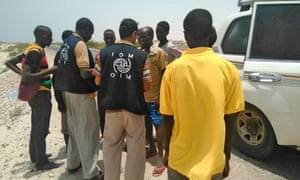At least 51 confirmed dead as survivors tell the Guardian of beatings and threats of shooting if they did not comply

Survivors say around 120 migrants were forced to jump into the sea 1km offshore because it was ‘not safe to land’. Photograph: UN Migration Agency
By Jason Burke in Nairobi
Traffickers used beatings and the threat of shooting to force more than 100 refugees, including children who could not swim, to jump into heavy seas off the coast of Yemen last week, survivors have said. At least 50 people were killed. The incident is the latest in a series in which hundreds, possibly thousands of refugees have died.
Survivors contacted in Yemen told the Guardian that crewmembers armed with AK47s told around 120 men, women and children that they would not be able to land them on beaches in Yemen and forced them to jump into the water while still at least 1km offshore at dawn on Tuesday.
The boat had left Bosaso, a port in Somaliland on the Gulf of Aden, around 16 hours earlier, the survivors said. Fifty-one refugees, mostly Somalis trying to reach Europe, have been confirmed dead, and the toll is expected to rise.
“The smugglers told us it was very risky to approach the shore as Yemeni authorities had arrested smugglers there. So they told us to jump. Some people shouted and begged the smugglers to take us closer, but they refused and started beating people with sticks. They had AK47s, so everyone was afraid to argue, and people started jumping into the sea,” Abdirahim Ilmi Aano, 25, a labourer in Bosasso, told the Guardian.
“Unfortunately, very few survived. I remember some were very young and did not know how to swim, ” Aano said when contacted by telephone in Yemen.
The International Organisation for Migration (IOM) said its staff found the shallow graves of 29 migrants on a beach in Shabwa governorate, Yemen, during a routine patrol on the morning of Tuesday. The dead had been buried hastily by survivors.
The IOM estimates that around 55,000 migrants have left the Horn of Africa to come to Yemen since January. More than 30,000 of those migrants are Somalians and Ethiopians aged under 18, and a third are estimated to be female. Most are hoping to find better economic opportunities in the Gulf countries or travel on elsewhere, and are fleeing drought, war and repression in their home countries.
On Thursday, in a second incident, smugglers carrying another boatload of largely Ethiopian refugees forced 160 people into the water at gunpoint. Five bodies have been recovered so far, and around 50 are reported missing, the IOM said in a statement last week. According to the agency, the approximate average age of the passengers on the boat was 16.
In March, Somalia’s government blamed the Saudi-led coalition fighting in Yemen for an attack on a boat that killed at least 42 Somali refugees off Yemen’s coast.
Despite the risks, Yemen remains attractive to African migrants because there is no central authority to prevent them from travelling onward.
This year, Somalia has been hit by a drought that has displaced 500,000 people and threatens more with starvation. Attacks by the al-Qaida linked al-Shabab Islamic militant group, which controls swaths of central and southern Somalia, have also intensified.
Suban Abdinor Shukur, 22, said her 19-year-old younger brother, who hoped to find work to pay for training as a computer engineer, was among those killed on Tuesday. “It’s a disaster for our family. I saw him off the night he was travelling to Yemen … My family live in poverty, so my brother wanted to help us get out of this bad life. He then said he will travel to Europe to find good job and then continue to get education and help mother back home,” Shukur said, speaking on the phone from Bosaso.
Mumino Dhubow, mother of a 17-year-old on the same boat, said she had sold family land and borrowed money to pay for his journey. Her son called her from Bosaso to tell her he had paid $500 to a smuggler for his passage across the Gulf of Aden and would leave shortly.
“Life is hard here. There is war. People are killed every day. Al-Shabab refused to allow food aid from humanitarian agencies to reach us. We could not cultivate our farms due to the drought. So my son was the only hope we had to survive. I have not heard from him. I am praying he will be OK,” Dhubow said.
More than 111,500 migrants arrived on Yemen’s shores last year, up from around 100,000 the year before, according to the Regional Mixed Migration Secretariat, a grouping of international agencies that monitors migration in the area.
Aano said he had left three children and his wife behind in central Somalian town of Beletwein, but could not return. He now plans to travel to Sudan by another unsafe, illegal sea journey and then on to Libya. The journey will cost between $5,500 to $7,000, he said.
Source: The Guardian


